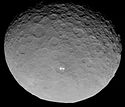
Vesta is one of the largest objects in the asteroid belt, with a mean diameter of 525 kilometres (326 mi). It was discovered by the German astronomer Heinrich Wilhelm Matthias Olbers on 29 March 1807 and is named after Vesta, the virgin goddess of home and hearth from Roman mythology.

Utopia Planitia is a large plain within Utopia, the largest recognized impact basin on Mars and in the Solar System with an estimated diameter of 3,300 km (2,100 mi). It is the Martian region where the Viking 2 lander touched down and began exploring on September 3, 1976, and the Zhurong rover touched down on May 14, 2021, as a part of the Tianwen-1 mission. It is located at the antipode of Argyre Planitia, centered at 46.7°N 117.5°E. It is also in the Casius quadrangle, Amenthes quadrangle, and the Cebrenia quadrangle of Mars.

Ceres is a dwarf planet in the middle main asteroid belt between the orbits of Mars and Jupiter. It was the first known asteroid, discovered on 1 January 1801 by Giuseppe Piazzi at Palermo Astronomical Observatory in Sicily, and announced as a new planet. Ceres was later classified as an asteroid and then a dwarf planet, the only one inside Neptune's orbit.

The Noachis quadrangle is one of a series of 30 quadrangle maps of Mars used by the United States Geological Survey (USGS) Astrogeology Research Program. The Noachis quadrangle is also referred to as MC-27.

The Thaumasia quadrangle is one of a series of 30 quadrangle maps of Mars used by the United States Geological Survey (USGS) Astrogeology Research Program. The Thaumasia quadrangle is also referred to as MC-25 . The name comes from Thaumas, the god of the clouds and celestial apparitions.
HiWish is a program created by NASA so that anyone can suggest a place for the HiRISE camera on the Mars Reconnaissance Orbiter to photograph. It was started in January 2010. In the first few months of the program 3000 people signed up to use HiRISE. The first images were released in April 2010. Over 12,000 suggestions were made by the public; suggestions were made for targets in each of the 30 quadrangles of Mars. Selected images released were used for three talks at the 16th Annual International Mars Society Convention. Below are some of the over 4,224 images that have been released from the HiWish program as of March 2016.
The common surface features of Mars include dark slope streaks, dust devil tracks, sand dunes, Medusae Fossae Formation, fretted terrain, layers, gullies, glaciers, scalloped topography, chaos terrain, possible ancient rivers, pedestal craters, brain terrain, and ring mold craters.
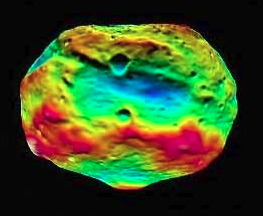
Feralia Planitia is the third-largest known impact structure on the asteroid Vesta, after Rheasilvia and Veneneia. It is one of several old, degraded impact basins that predate the Rheasilvia basin that now dominates Vesta. It is situated near the equator, and is 270 kilometres (170 mi) across east to west, though compressed latitudinally by the Rheasilvia impact.

Several bright surface features were discovered on the dwarf planet Ceres by the Dawn spacecraft in 2015.

In summer 1965, the first close-up images from Mars showed a cratered desert with no signs of water. However, over the decades, as more parts of the planet were imaged with better cameras on more sophisticated satellites, Mars showed evidence of past river valleys, lakes and present ice in glaciers and in the ground. It was discovered that the climate of Mars displays huge changes over geologic time because its axis is not stabilized by a large moon, as Earth's is. Also, some researchers maintain that surface liquid water could have existed for periods of time due to geothermal effects, chemical composition or asteroid impacts. This article describes some of the places that could have held large lakes.

Occator is an impact crater located on Ceres, the largest object in the main asteroid belt that lies between the orbits of Mars and Jupiter, that contains "Spot 5", the brightest of the bright spots observed by the Dawn spacecraft. It was known as "Region A" in ground-based images taken by the W. M. Keck Observatory on Mauna Kea.
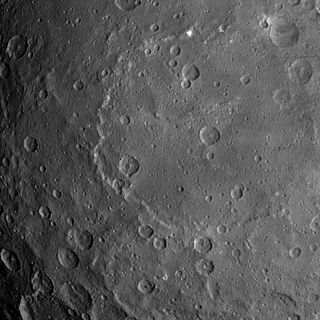
Kerwan is the largest confirmed crater and one of the largest geological features on Ceres. It was discovered on February 19, 2015 from Dawn images as it approached Ceres. The crater is distinctly shallow for its size, and lacks a central peak. A central peak might have been destroyed by a 15-kilometer-wide crater at the center of Kerwan. The crater is likely to be young relative to the rest of Ceres's surface, as Kerwan has largely obliterated the cratering in the southern part of Vendimia Planitia.
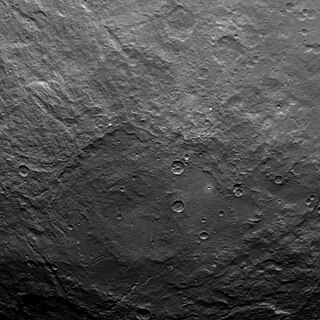
Yalode is the second-largest confirmed crater on Ceres, after Kerwan. It is adjacent to another large crater, Urvara and serves as the namesake for the Yalode Quadrange. Yalode named after the Dahomeyan (Fon) deity of the yam harvest, Yalodé; the name Yalode was officially approved by the International Astronomical Union (IAU) on 3 July 2015.
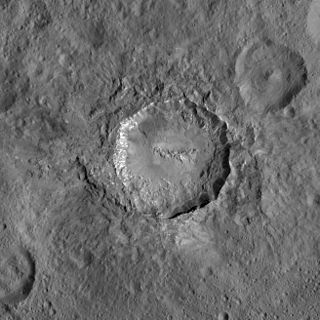
Haulani is an impact crater located on Ceres that contains "Spot 1", one of the bright spots observed by the Dawn spacecraft. The crater was named after Haulani, the Hawaiian goddess of plants. In July 2018, NASA released a comparison of physical features, including Haulani crater, found on Ceres with similar ones present on Earth.

Coniraya is a large, shallow crater on the dwarf planet Ceres. It is the namesake for the Coniraya Quadrangle.

Dantu is a large crater on Ceres, located within the Vendimia Planitia. It is rimmed by a number of minor faculae, which together form Bright Spot 2.

The geology of Ceres consists of the characteristics of the surface, the crust and the interior of the dwarf planet Ceres. The surface of Ceres is comparable to the surfaces of Saturn's moons Rhea and Tethys, and Uranus's moons Umbriel and Oberon.

Achita is a large crater on Ceres.

Nawish is a crater on the dwarf planet Ceres. It is named after the Acoma guardian of the field. The name was officially approved by the International Astronomical Union (IAU) on 3 July 2015. It is the namesake of the Nawish Quadrangle.

Sintana is a large central peak crater in the Southern Hemisphere of the dwarf planet Ceres, located at 44.21° S, 76.4 ° E. It has a diameter of 58 km. The crater is named after the deity of the Kogi people of northern Colombia who produced fertile black earth. It was officially named by the International Astronomical Union (IAU) on July 3, 2015. It is the namesake of the Sintana Quadrangle.



















